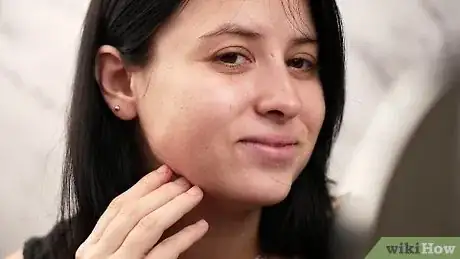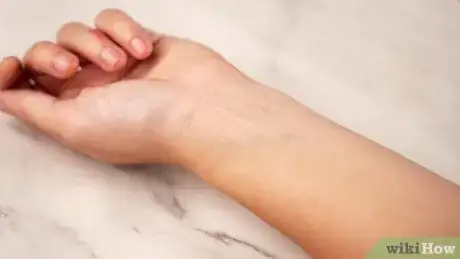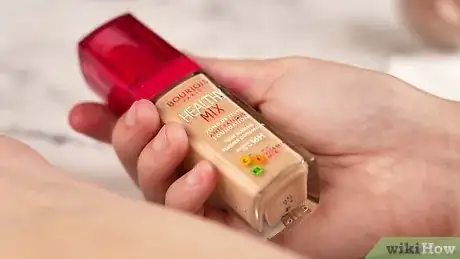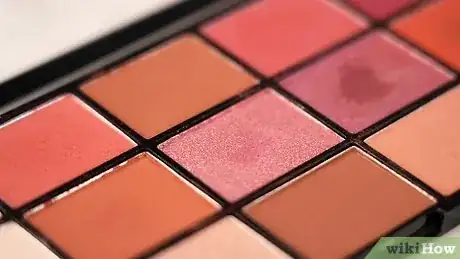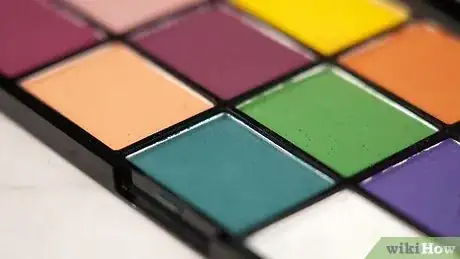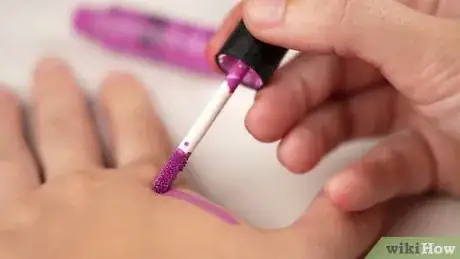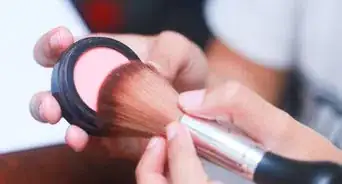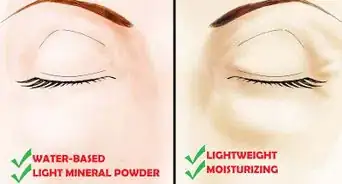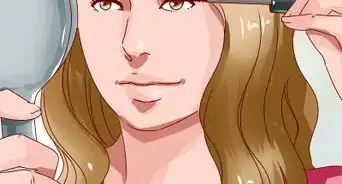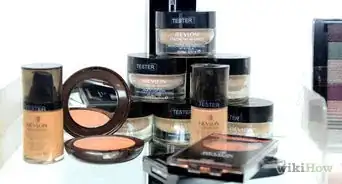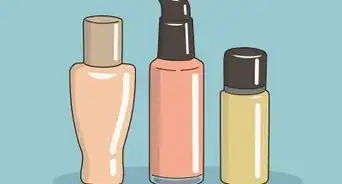X
This article was co-authored by Yuka Arora. Yuka Arora is a self-taught makeup artist who specializes in abstract eye art. She has been experimenting with makeup art for over 5 years, and has amassed over 5.6K Instagram followers in just 5 months. Her colorful and abstract looks have been noticed by Jeffree Star Cosmetics, Kat Von D Beauty, Sephora Collection, among others.
This article has been viewed 192,062 times.
One of the most important steps to applying your makeup is finding colors that suit your skin tone and eye color. You can then select foundation and blush that complement your skin, and eyeshadow and lip color that help you look your best.
Steps
Method 1
Method 1 of 3:
Selecting Foundation and Blush
-
1Determine your skin tone by looking at the shade along your jaw line. In the makeup world, there are four basic skin tones: fair, light (or olive), medium, and deep brown. You can determine your skin tone by looking at the skin on your jawline.[1]
- If your skin appears very pale or white in color, you likely have a fair skin tone.
- If your skin appears pale with slightly brown or yellow coloring, you likely have a light skin tone.
- If your skin appears light brown, like you have a light tan all over your face, you likely have a medium skin tone.
- If your skin appears dark tan or dark brown in color you likely have a deep brown skin tone.
-
2Identify your undertones. Undertones are useful because they can help you determine what foundation you should use on your skin. There are three types of undertones: warm, cool, and neutral. To determine your undertones, you can use a piece of silver fabric and a piece of gold fabric. [2]
- Place each piece of fabric next to the inside of your wrist. If the veins on your wrist appear blue next to the silver, you are cool toned. If the veins on your wrist appear yellow, green, or brown next to the gold fabric, you are warm toned. If your veins appear blue and green, you are neutral toned, so you can wear both cool and warm tones.
- You can also determine your undertone by putting on a black top. If you look washed out in black, you are warm toned. If you appear tanned in black, you are cool toned.
- Most people with warm tones look better in gold jewelry and most people with cool tones look better in silver jewelry. People with a neutral undertone can wear both gold and silver jewelry.
Advertisement -
3Combine your skin tone and your undertones to find your foundation shade. Once you have determined your skin tone and your undertones, you can select a foundation that is right for your skin. For example, if you have a fair skin tone and a warm undertone, foundation in light ivory or porcelain may be right for you. If you have a medium skin tone and a cool undertone, foundation in beige or brown may be ideal.[3]
- You can use an online tool to determine your foundation shade based on your skin tone and your undertone. You can also talk to a beauty expert at a beauty supply store or at your local drug store to ensure you choose the right foundation for your skin.
- Keep in mind, if you are in doubt, it is usually better to choose a foundation that is darker than your skin tone. If you blend the color well, you can end up looking tanned and glowy. If you choose a foundation that is too light for your skin tone, you could end up looking chalky and sallow.[4]
-
4Test the foundation before you buy it. Though you may be confident you have chosen the right foundation shade for your skin, you should always test the product before committing to it. You can ask a beauty salesperson for a sample of the foundation and apply it to your skin to ensure it is the right hue.[5]
- Swipe a small amount of the shade along your jawline and note the color of your neck, which is often lighter than the color of your face. The correct hue should disappear into your skin and blend well.
- Make sure you are testing the foundation in natural lighting. Stand by a window or go outside to ensure the color blends well into your skin and does not look chalky or too tanned.
-
5Choose blush based on your skin tone. Blush is a nice way to warm up your face but still appear natural and effortless. You can select blush based on your skin tone for a glowing look that does not wash out or overwhelm your complexion.
- If you have fair skin, choose a blush in pale pink. Blush in peach and plum are also ideal to add a hint of color to fair skin.
- If you have light/olive skin or medium skin, choose a blush in apricot, with a tinge of orange. Many people with light/olive skin have warm undertones that are enhanced with apricot blush. Mauve is also a good option as well as medium pink or orangey pink.
- If you have darker skin, go for blush in light purple or purple-pink. Dark skin is great for bold pigments like a deep terra cotta blush or a bright tangerine blush.
Advertisement
Method 2
Method 2 of 3:
Choosing Eyeshadow
-
1Identify your eye color. To find eyeshadow and mascara that is right for you, you first need to properly identify your eye color. There are four main eye color types: blue eyes, hazel-brown eyes, dark brown/black eyes, and green eyes.
- If you happen to have heterochromia, where you have two different colored eyes, you may want to factor in your skin tone to help you choose eyeshadow. Try to choose the same eyeshadow color for both eyes, though different eyeshadow colors on each eye can make for a quirky, fun look.
-
2Choose eyeshadow in warm hues like gold and orange if you have blue eyes. Blue eyes really pop when they are framed with eyeshadow in warm hues like gold, orange, peach, pink, coral, beige, bronze, or apricot. In general, orange is a complementary color for blue, so eyeshadow in variations on orange are a good option for this eye color.
- You may want to avoid eyeshadow in blue-green, as this shade can reduce the intensity of your blue eyes.
- You can try color combinations like peach and gold or coral and pink to create a fun eyeshadow look. Try starting with the peach or pink first on your inner eyelids, then adding a light layer of gold on your outer eyelids.
-
3Select eyeshadow in pink or purple if you have green eyes. Green eyes look great with cool shades like plum, purple, pink, mauve, red-brown, crimson, and copper. Look for eyeshadows in these colors and avoid blue eye shadow or green eye shadow, as they will not enhance your eyes.
- You can try color combinations like plum and pink or purple and then a lighter purple shade. Start with the darker colors first, like plum or purple, on your inner eyelids and then finish your look with a layer of the lighter colors, like pink or light purple, on your outer eyelids.
-
4Go for eyeshadow in gray-green, gold, or orange if you have hazel-brown eyes. Hazel-brown eyes look great with many shades, from gray-green to golden brown. You can also apply eyeshadow in orange, khaki, blue-gray, gold, or light brown.
- Put together color combinations like gray-green and gold or orange and golden brown. Start with the darker shade on your inner eyelid first, like gray-green, and then add a layer of the lighter shade on your outer eyelid, like gold or golden brown.
-
5Try eyeshadow in deep, cool shades if you have dark brown or black eyes. Go for deep shades that will highlight your dark eyes, such as dark gray, navy blue, deep plum, or brown. You should avoid pastels shades or very light, pale shades, as they can make you look washed out.
- You should also try eyeshadows that contain metallics, like gold, silver, copper, or bronze, to add some light to your dark eyes. Avoid matte eyeshadows.
- Create color combinations like navy blue and silver or deep plum and bronze. You can then apply the darker shade first, such as navy blue, on your inner eyelids, and then finish with the lighter shade, such as silver, on your outer eyelids.
-
6Choose eyeliner and mascara that complements your eye color. You should also consider other eye makeup like eyeliner and mascara. Often, black mascara and black eyeliner can look good with almost any eye color. You can do a dramatic cat eye or winged eyeliner with black eyeliner and finish with a few swoops of mascara for a night out or put eyeshadow on top of black eyeliner for a fun look. However, certain eyeliner colors look better with certain eye colors, making your eye color really pop.
- If you have blue eyes, go for eyeliner in copper or gold.
- If you have green eyes, choose eyeliner in bronze or purple.
- If you have hazel-brown eyes, go for eyeliner in bronze, olive, purple, or green.
- If you have dark-brown or black eyes, choose eyeliner in amber, midnight blue, purple, or gray
Advertisement
Method 3
Method 3 of 3:
Picking Lipstick
-
1Go for bold, bright lipstick if you have a darker skin tone. If you have a medium or deep brown skin tone, you may want to try lipstick in a bright color like bright pink, bright purple, or bright red. Bright colors will pop against your skin tone and enhance the warm undertones of your complexion.[6]
- Try to maintain a balance of color on your face by wearing a bold lipstick color with paired down eyeshadow and foundation. If you go for a bright eyeshadow look, you may wear lipstick in a more neutral color like nude or light pink.
-
2Choose lighter colored lipstick if you have a lighter skin tone. Lighter skin tones, such as fair, or olive, look good with lipstick in light pink, nude, or light purple. These shades will not overwhelm your pale skin tone and will add warmth to your face.[7]
-
3Enhance your lips if they appear small. If you feel your lips are small and you would like to enhance them, you can try using lipstick that is pearlescent or metallic, as they will add shine and depth to your lips. You may also try lipstick in light colors like pink, peach, or beige so your lips are not overwhelmed by a bright, dark color.
- Another trick is to use a lip pencil to create a new lip line outside of your natural lip line. Try to go no further than 3mm out. Make sure the line is precise and even. You can then color in your lips with the lip pencil or with lipstick that is the same shade as the lip pencil.
Advertisement
Community Q&A
-
QuestionWhat color eye shadows should I use with light blue-green eyes?
 Community AnswerPinks complement green eyes best, however you can also use bronze/gold tones.
Community AnswerPinks complement green eyes best, however you can also use bronze/gold tones. -
QuestionWhat lip color should I wear to a day party?
 Community AnswerTypically a lot of people wear a nude or light pink color during the day, but for a party you can definitely be bold with red or purple.
Community AnswerTypically a lot of people wear a nude or light pink color during the day, but for a party you can definitely be bold with red or purple. -
QuestionI have the foundation. Do I need power to complete my look?
 Community AnswerIf you find your base slipping and sliding, or if your face is particularly oily, powder would help.
Community AnswerIf you find your base slipping and sliding, or if your face is particularly oily, powder would help.
Advertisement
References
- ↑ http://www.lorealparisusa.com/en/tools-and-consultations/face-makeup-consultation.aspx
- ↑ https://stylecaster.com/beauty/cool-warm-skin-undertones/
- ↑ http://www.lorealparisusa.com/en/tools-and-consultations/face-makeup-consultation.aspx#continue
- ↑ http://www.fitnessmagazine.com/beauty/makeup/makeup-foundation-tips/?page=5
- ↑ http://www.fitnessmagazine.com/beauty/makeup/makeup-foundation-tips/?page=4
- ↑ http://www.oprah.com/style/How-to-Choose-the-Right-Colors-for-You/4
- ↑ http://www.oprah.com/style/How-to-Choose-the-Right-Colors-for-You/4
About This Article
Advertisement
